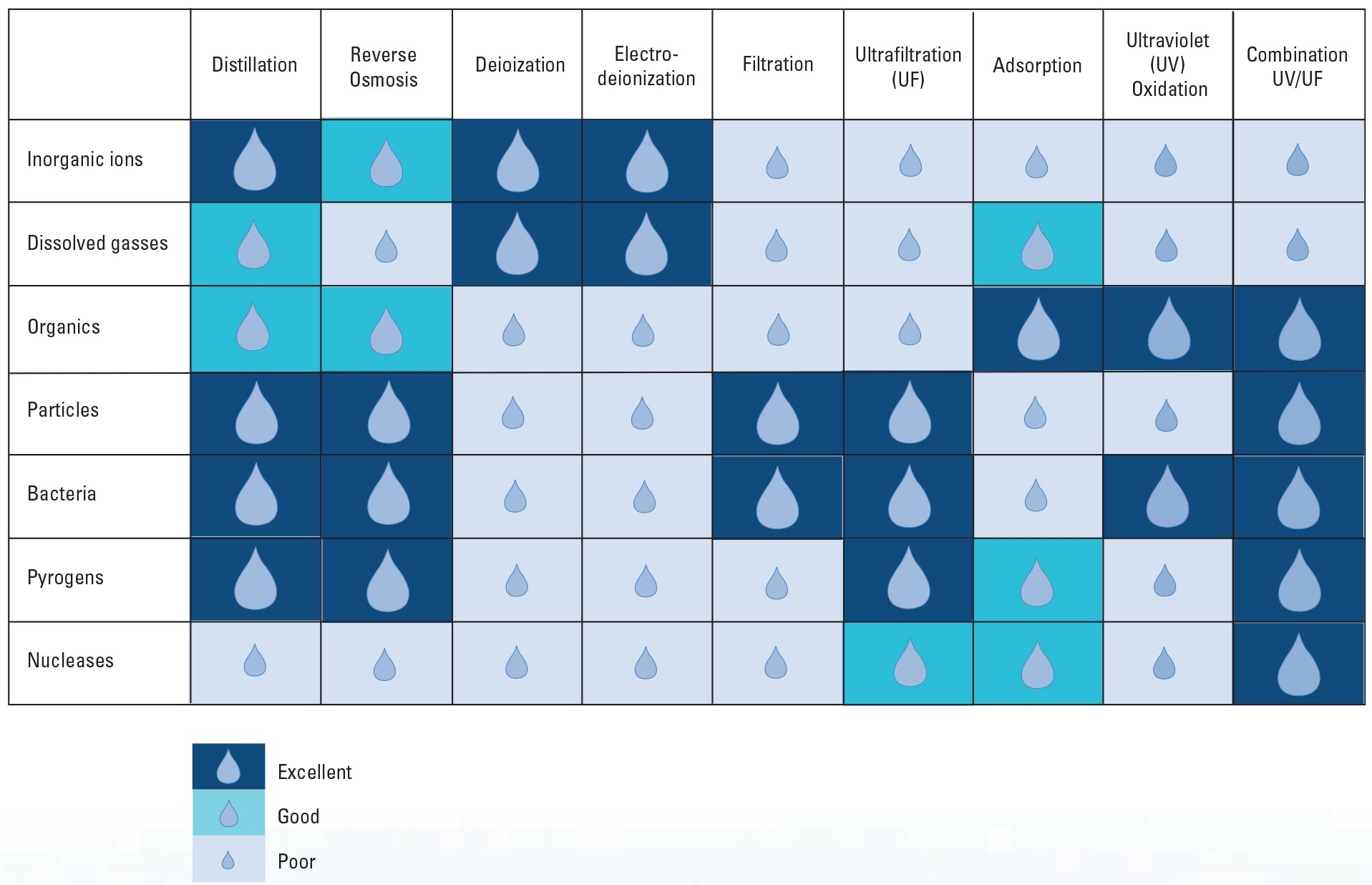Water systems use several technologies to remove impurities to produce pure water. Of course, water purity is dependent on proper system maintenance.
 Common Water Impurities
Common Water Impurities
Don’t let impurities contaminate your sensitive experiments. Thermo Scientific™ Barnstead™ water purification systems are engineered to remove impurities that threaten your research so you can focus on what’s important – your next discovery.
Suspended Particles
Sand, silt, clay and other suspended particles cause water to be turbid. These suspended particles can interfere with instrument operation, plug valves and other narrow flow paths, and foul reverse osmosis membranes. They typically range from 1 – 10 µm in size.
Colloids
Colloidal particles typically have a slightly net negative charge, range in size from 0.01 – 1.0 µm, and can be either organic or inorganic. Unlike suspended particles, colloids do not settle out by gravity, but remain suspended in the liquid that carries them. Colloids clog filters, interfere with instrument operation, foul reverse osmosis membranes and can bypass ion exchange resins, resulting in lower resistivity in deionized water systems.
Inorganic Ions
Impurities such as silicates, chlorides, fluorides, bicarbonates, sulfates, phosphates, nitrates and ferrous compounds are present as cations (positively charge ions) and anions (negatively charged ions). Water with a high concentration of ions will conduct electricity readily and have high conductivity and low resistivity, as conductivity and resistivity are inversely related. Ions will adversely affect the results of inorganic analyses such as IC, AA, ICP/MS and may retard cell and tissue growth in biological research. They can also affect the cartridge life in deionized water systems.
Dissolved Organics
Organic solids are present from plant and animal decay and from human activity. They may include proteins, alcohols, chloramines and residues of pesticides, herbicides and detergents. They foul ion exchange resins, interfere with organic analyses including HPLC, gas chromatography and fluoroscopy. They will also hinder electrophoresis, tissue and cell culture.
Dissolved Gases
Water naturally contains dissolved gases such as carbon dioxide, nitrogen and oxygen. Carbon dioxide dissolves in water to form weakly acidic carbonic acid (H2CO3), which can alter the pH of the water. Additionally, oxygen, the most common non-ionized gas, may cause corrosion of metal surfaces.
Microorganisms
Bacteria, fungi and algae are found in all natural water sources. Chlorination eliminates harmful bacteria, but tap water still contains live microorganisms which interfere with sterile applications, such as cell and tissue culture.
Pyrogens and Viruses
Pyrogens or bacterial endotoxins are lipopolysaccharide molecules incorporated in the cell membrane of gram negative bacteria. Viruses are considered to be non-living nucleic acids. Both can adversely affect laboratory experiments often hindering cell and tissue growth in culture.
Nucleases
RNase and DNase are naturally occurring enzymes that are instrumental in regulating bodily functions. As important as these enzymes are to the life process, they can be devastating to nucleic acid experiments. If these contaminants are present in the lab water used, the ability to amplify DNA molecules will be severely limited. Likewise, experiments utilizing RNA can be ruined.
Water Purification Systems
To make pure and ultrapure water, the impurities discussed above must be efficiently and effectively removed. Barnstead water purification systems employ multiple technologies, some synergistically, to remove impurities and give you consistently PURE water.
Water purification is a step-by-step process often requiring a combination of technologies, each of which varies in the ability to remove specific contaminants.
The table below illustrates which impurities are removed by each technology.

Water Purification System Maintenance
Our on-demand webinar, Ultrapure water and cell culture: Know why, what, and how for proper water system maintenance, with Kim Knepper, Global Application Specialist at Thermo Fisher Scientific for Water Purification, takes you through the complexities and importance of water quality in the lab. Whether your use for water is making reagents, tissue culture media and buffers, or filling water baths and reagents, your feedwater quality is paramount.
To learn more about impurities found in water and how to remove them, watch the full recorded, on-demand webinar.
Learn More:




Leave a Reply